Manu Road
Today we left Cusco to drive the Manu Road, a very long track more than a road but one that is quite well used despite its rough nature. Our first stop was when I shouted that we had just past an Andean Ibis sitting on the ground. We piled out of the bus and managed to get everyone on the bird. It was hard to see for some because it was closer than most people expected! We found another Andean Ibis hiding in some reads and had a nice comparison with a Puna Ibis. Andean Lapwings provided the supporting cast. Despite his extensive experience in Peru Frank said he had never seen Andean Ibis so well. Next stop was a rather barren and arid field where we found three Slender-billed Miners and a Spot-billed Ground-tyrant. A raptor appeared over a ridge and we all got onto Cinereous Harrier.
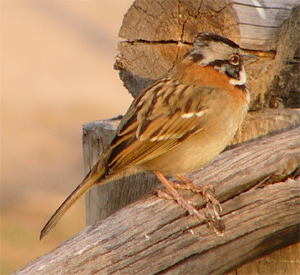
Rufous-collared Sparrow
We stopped in a town to refuel and spent some time on the bridge over the river. Common Peruvian birds were seen here: Black Phoebe, Torrent Tyrranulet, Blue-and-yellow Tanager, Chiguanco Thrush and, of course, Rufous-collared Sparrow. Then it was back to serious birding and the hunt for the next endemic. A bush and tree strewn valley was the site and bird-filled it proved to be. Our target was soon seen, four Creamy-crested Spinetails, exceptionally good-looking birds I must say. Flower-covered trees held Tufted Tit-tyrant and White-tufted Sunbeam plus a Crimson-mantled Woodpecker and a White-bellied Woodstar.
Back on the road until we reached the border of Manu Cloud Forest Reserve at Tres Cruces. Whilst the drivers set up the table and cooked lunch we walked down a path to see what we could find. Black-throated Flowerpiercers were again found as was Moustached Flowerpiercer, soon followed by a very attractive Grass Wren. Then came Scribble-tailed Canastero, performing for us nicely in the grass, more D'Orbingy's Chat-tyrants, three Cinereous Conebills, White-throated Tyrranulet, Tufted Tit-tyrant and Mountain Caracara.
This evening we were to camp high in the mountains. As ever, our superb drivers did all the work and set up the tents whilst we went birding. Our first stop gave us the first of many Shining Sunbeams. A calling bird was tracked down and found to be a diminutive Black-throated Tody-tyrant. Mountains species continued to be found: Sierran Elaenia, Scarlet-bellied Mountain-tanager, Great Thrush and Dark-faced Brush-finch. Near the camp we had a small flock of tanagers comprising Scarlet-bellied Mountain-tanagers and Golden-collared Tanagers.
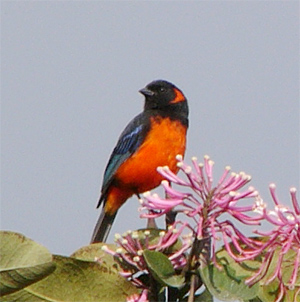
Scarlet-bellied Mountain-tanager
Time for a drive a little way down the mountain and we hit a bird flock. This is where the excitement and tension really mount. Lotso of birds, mixed flock, moving quickly. So much to see and identify as bird names are called from all directions. Blue-capped Tanagers were found as was a Streak-throated Bush-tyrant. We were distracted by two beautiful Gray-breasted Mountain-toucans but were soon back with Hooded Tanager and Capped Conebill. A male Gould's Inca was found, a very good-looking hummer, plus White-crested Elaenia and Chestnut-bellied Mountain-tanagers. A Long-tailed Sylph was spotted as were three Blue-and-black Tanagers, Superciliared Hemispingus and Pearled Treerunner. A very attractive endemic was our next target and Marcapata Spinetail was soon on the ever-growing list. Then it was time for another flock and it all started again! White-banded Tyrranulet, Mountain Wren, Rust-and-yellow Tanager, Citrine Warbler and Spectacled Whitestart were all new for the trip.
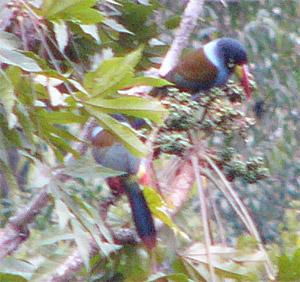
Gray-breasted Mountain-toucan
Almost our last bird was a real gem. At a secret site we were led down a path and one individual of our target species was seen briefly by a couple of people in front but quickly disppeared. Had we missed our only chance? Frank walked down the path and soon called quietly that we should come down. We descended as quickly as possible and the whole group was soon admiring a truly special bird. At a distance of about five metres we watched a Red-and-white Antpitta in the open, showing superbly. A very special moment for all of us.
The last birds seen in daylight were two Andean Guans and the last bird of the day was seen when we walked the road in the dark. An owl flew right over our heads and we were all surprised, and admittedly slightly disappointed, to note that it was a Barn Owl, albeit of the contempta race!
A pre-dawn gathering saw us standing only metres from our tents listening for Swallow-tailed Nightjar. One bird flew past giving rather brief views and we heard drumming Andean Snipe.
We were heading down the mountain aiming for the famous Cock-of-the-Rock Lodge. It was quite a way to go and we had a lot of birding to do. Forest birding here is definitely a case of bursts of excitement interspersed with periods of no birds at all unless we were at a specific site for a specific bird. So, our first flock appeared and we sorted through Chestnut-bellied Mountain-tanagers, Blue-and-yellow Tanagers, Grass-green Tanager, Hooded Tanager and Black-backed Grosbeak. Shing Sunbeams were seen at all stops and we soon also picked up Azara's Spinetail, Great Thrush and Mountain Cacique. Two birds half-hidden in a bush turned out to be White-collared Jays. Our next stop added the very nice Rufous-breasted Chat-tyrant and our first of many Cinammon Flycatchers, another classy-looking bird. These were soon followed by two Andean Guans and another of our target birds, a Barred Fruiteater.
This was the situation along most of the road: stops when we saw a flock and lots of birds to look at. Next stop gave us many of the same birds, a good thing as some people had birds they still needed to catch up with plus Glossy-black Thrush and Masked Flowerpiercer. A stop looking down the valley gave us yet another flock including two Pearled Treerunners, Barred Becard and Smoke-colored Pewee.
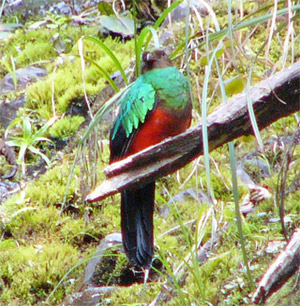
Golden-headed Quetzal
We stopped on a corner and Frank played a call. The bird we were looking for could be seen here he said. Could be? Within seconds a superb male Golden-headed Quetzal flew straight over our heads and sat in a tree above us, easily 'scopable. In the next few tens of metres we saw six of these birds! In this area we also found a Strong-billed Woodcreeper, Streaked Tuftedcheek, Mountain Wren, Fawn-breasted Tanager and Slaty Tanager. A little further on we picked up a distant flying Black-and-chestnut Eagle, soon followed by Ochraceous-breasted Flycatcher and a very beautiful Maroon-chested Chat-tyrant. Now it was time to stop of lunch. Stop? We had a hummingbird that kept whizzing in and out and we had to identify it so our periods of sitting down didn't last long. We saw it well and identified it as Buff-thighed Puffleg. During this time we also found Bolivian Tyrranulet and two Montane Woodcreepers.
Back on the road, well, walking down the road another flock was encountered that included, amongst those we had already seen but were happy to see again, new birds in the form of Yellow-whiskered Bush-tanager, Rufous-chested Tanager, Saffron-crowned Tanager, Brown-capped Vireo and Pale-edged Flycatcher. Chestnut-collared Swifts flew overhead and a close adult Black-and-chestnut Eagle showed well.
Then we hit a small problem: a traffic jam! There had been a landslide about a kilometre down the road from us and no-one could pass. Fortunately a group of workers were on the scene to rebuild the road. Not a problem as while they did that we went birding and came across some good birds: Beryl-spangled Tanager, Ochre-faced Tody-tyrant, Yellow-throated Tanager, Orange-bellied Euphonia and noisy, fly-past Scaly-naped Amazons. We also managed to lure into view a Southern White-crowned Tapaculo. By now the road had been repaired but we took the precaution of walking over the rebuilt section and the bus followed us!
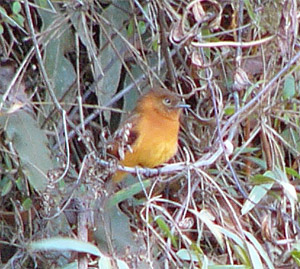
Cinammon Flycatcher
Not long later we stopped again and found, you guessed it, another flock of birds. Common Bush-tanager was added to our ever-growing list as was Versicolored Barbet, Blue-winged Mountain-tanager and Black-capped Hemispingus. Our final stop of the day was at dusk. We were told to stand looking up a wooded mountainside and wait. About fifteen minutes later we gave a collective gasp as an adult male Lyre-tailed Nightjar suddenly appeared from the wood, circled over head and disappeared back into the forest. A great end to another great day and satisfied we headed down the road to the Cock-of-the-Rock Lodge.
Dawn saw us breakfasting and birding the lodge garden. As we watched birds began coming in or moving through: Golden Tanager, Paradise Tanager, Silver-beaked Tanager, Blue-gray Tanager and Buff-throated Saltator. The garden had a few hummingbird feeders and these attracted Violet-fronted Brilliant, Wire-crested Thorntail, Many-spotted Hummingbird, Sparkling Violetear, Wedge-billed Hummingbird and Booted Racket-tail. We also had our first Speckled Chachalacas and our first Bananaquit.
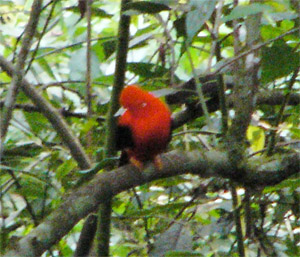
Andean Cock-of-the-Rock
Then it was time for the reason people come here, the Cock-of-the-Rock lek. As the door to the viewing platform was opened we were immediately faced with a male Andean Cock-of-the-Rock. We filed in and sat down to watch three displaying males, superb birds. In the trees we also found Russet-crowned Warbler and Slate-throated Whitestart. Walking up the road it was again flock time and we found Streak-necked Flycatcher, Marble-faced Bristle-tyrant, Orange-eared Tanager, Spotted Tanager and Yellow-throated Bush-tanager. In a dark gap in the trees, after some intense searching, we were delighted to locate a male Yungas Manakin.
Walking further up the road we encountered individual birds and more flocks: Tropical Kingbirds, Social Flycatchers, Gray-mantled Wren, Lemon-browed Flycatcher, Three-striped Warbler, Black-goggled Tanager, Yellow-breasted Antwren and some Brown Capuchin monkeys. Various other stops added more great birds: Crested Quetzal, Streaked Flycatcher, Scale-crested Pygmy-tyrant and Golden-crowned Flycatcher.
We made a short drive up the road to a rocky and wooded steep mountainside split by a river. In almost no time we had found a pair of the much-wanted White-capped Dipper and a couple of Black Phoebes. We could hear our target bird calling, and it came close, we our hoped-for Andean Solitaire did not want to show! We had, eventually, to give up but were more than pleased when a Bronzy Inca appeared and fed on some flowers by the roadside.
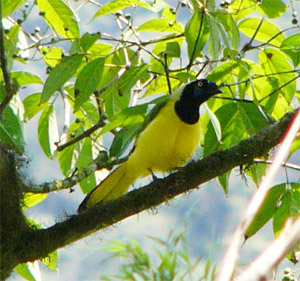
Inca Jay
Heading back down the road for lunch at the lodge we added Inca Jay and Blue-necked Tanager to our lists.
After lunch we walked around the grounds of the lodge. The vegetation was thick and finding species was not easy but with perseverance we were successful. Our first new bird was Tropical Parula. Then we picked up Fulvous-breasted Flatbill and Black-eared Hemispingus. Then , with work, we managed to see a very elusive Slaty Gnateater, Trevor's four-thousandth life bird! Back at the lodge Frank found a Stripe-breasted Antwren, soon joined by a second, and an Andean Slaty-thrush.
Then it was time to go back up the mountain road. The first thing we found was a Woolly Monkey, which apparently are hard-to-see and not common. Dusky-green Oropendolas kept flying up and down the valley and we found our first Russet-backed Oropendola (much more common lower down). Mixed flocks were again encountered and again we enjoyed the colourful tanagers. New birds were Blue Dacnis, Purple Honeycreeper, Montane Foliage-gleaner and Olive-backed Woodcreeper. At another of Frank's many sites we found Ash-browed Spinetail but were soon distracted by a large mixed flock of mostly tanagers. Bay-headed Tanager was new for the list as was the quite-rare Yellow-rumped Antwren. Olivaceous Siskins were amongst the tanagers as was a Slaty-capped Flycatcher.
We continued higher up the mountain and were rewarded with a hoped-for Highland Motmot, with a startling turquiose crown, showing very well plus a Blue-banded Toucanet and a female Andean Cock-of-the-Rock. Our final stop of the day was when we heard Andean Solitaire again and we eventually saw two birds albeit rather briefly.
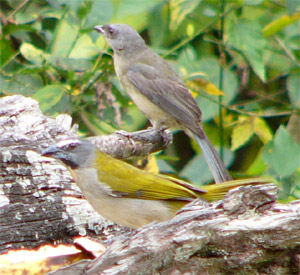
Buff-throated Saltator and Blue-and-yellow Tanager
After dinner we gathered at the lodge entrance and played the call of Rufescent Screech-owl. A bird replied but sounded like it was way across the valley. However, Frank knew better and soon located a calling bird in the lodge grounds, sitting on an open branch right next to the path! This bird has a very quiet call but was happy to show itself very well.
Just after dawn we walked down the mountain by the side of a river. A Highland Motmot was seen briefly and we admired another pair of White-capped Dippers. A bus ride took us further down to a specific site for what seemed to be one of the world's most elusive birds: Cabani's Spinetail. We could hear them and got very brief views but they really are skulkers! Eventually most of us had seen enough bits of bird to be able to identify the whole. A little further down we added Warbling Antbird, heard and saw a Chestnut-backed Antshrike and admired two Bluish-fronted Jacamars. In a more open area, where an old landslide had cleared the vegetation and thick vegetation had not returned, we picked up Yellow-browed Sparrow, Brown-chested Martin, Chestnut-bellied Seedeater and Violaceous Jay. We also picked up our first Plumbeous Kite here. Another bird flock added Streaked Xenops, Two-banded Warbler and White-winged Tanager.
Near a rocky outcrop we stopped as we heard a never-to-be-seen Chestnut-breasted Wren. It came close but never came out. Most frustrating. However, all was not lost as we admired a superb Ornate Flycatcher and found Cusco Warbler (split from Golden-bellied Warbler and now an endemic). Nearby we picked up Magpie Tanager and a pair of Long-tailed Tyrants. Our first Southern Rough-winged Swallows put in an appearance and we found Gray-capped Flycatcher and Black-faced Dacnis.

